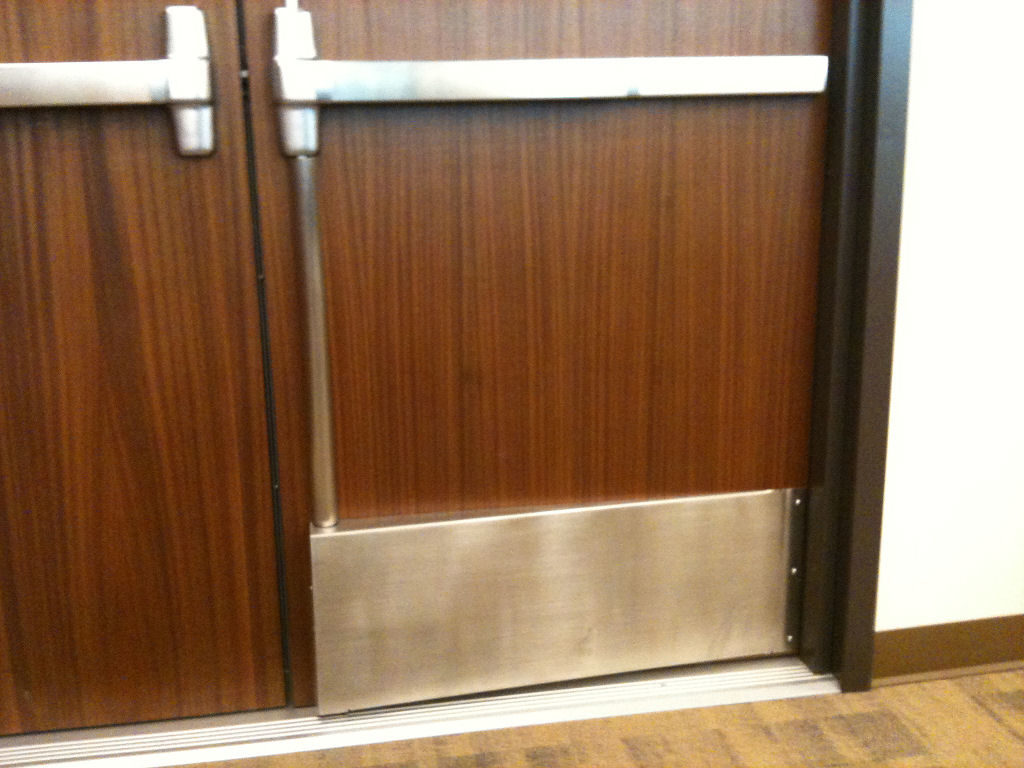 Once again, I’m shocked to be following up with additional information on a post that I originally wrote 8 YEARS AGO. This question has come up several times lately:
Once again, I’m shocked to be following up with additional information on a post that I originally wrote 8 YEARS AGO. This question has come up several times lately:
Can extended latch guards be installed to bring doors with surface vertical rods into compliance with the accessibility standards?
First, a reminder of the accessibility requirement this question is in reference to (more info here)…
The 2010 ADA Standards for Accessible Design and ICC A117.1 – Accessible and Usable Buildings and Facilities require manually-operated doors (not automatic doors) to have a flush, smooth surface on the bottom of the push side, measured from the floor to 10 inches up the face of the door. There are a few exceptions – some all-glass doors, sliding doors, and doors that do not extend to within 10 inches of the floor, but this requirement means that most doors must have at least a 10-inch (nominal) bottom rail with no protruding hardware in that area.
When hardware projects off the face of the door on the push side, in the 10-inch area at the bottom, it could catch the crutch, cane, or wheelchair footpad of someone attempting to use the door. Hardware that would be non-compliant includes kick-down holders, full-height door pulls (mounted on the push side), and surface vertical rod panic hardware with the bottom rod and latch installed.
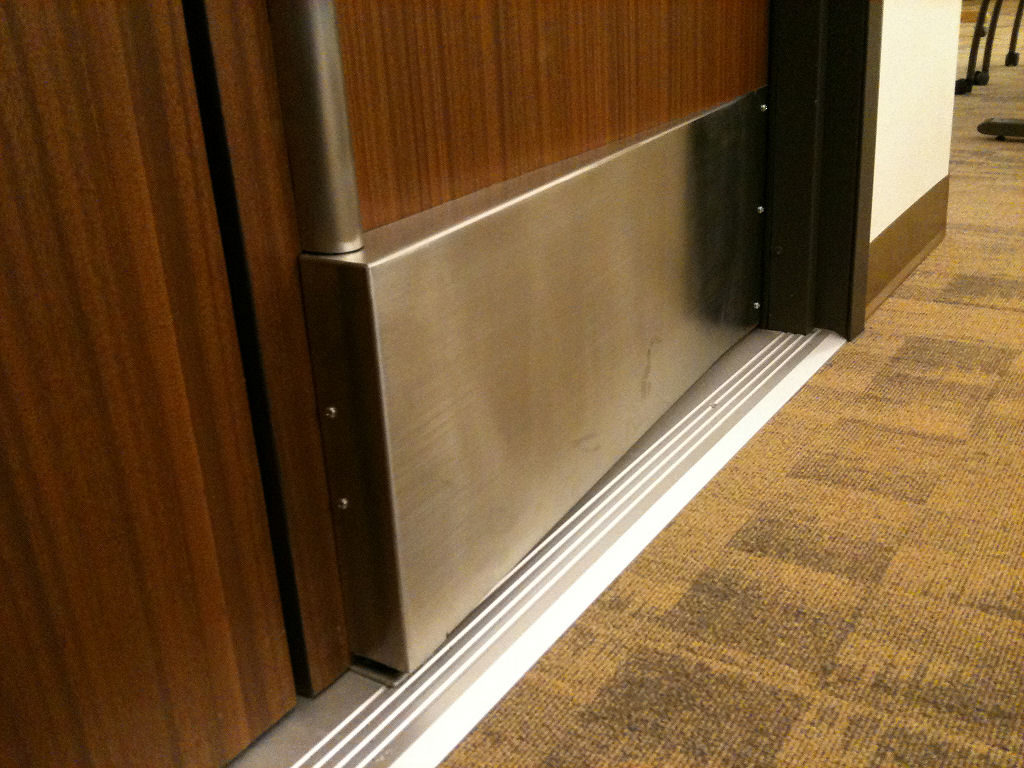 Back in 2011, I asked ICC staff and several AHJs whether extended rod guards creating a sloped surface across the door width and over the bottom latch would meet the intent of the accessibility standards, and their answer was that it would meet the intent. Technically, the door would not be compliant because the difference between the plane of the door face and the plane of the extended latch guard would be more than 1/16-inch. (That post is here.)
Back in 2011, I asked ICC staff and several AHJs whether extended rod guards creating a sloped surface across the door width and over the bottom latch would meet the intent of the accessibility standards, and their answer was that it would meet the intent. Technically, the door would not be compliant because the difference between the plane of the door face and the plane of the extended latch guard would be more than 1/16-inch. (That post is here.)
So why am I writing a follow-up post? The other day I noticed something new in the 2017 edition of the ICC A117.1 Commentary. In the section discussing the requirements and exceptions for the flush, smooth surface, the Commentary now states:
In addition to the door stop indicated in the commentary figure, common errors are hardware that extends the full height of the door or panic hardware with the vertical rod below the hardware on the outside face of the door. Hardware must stop at least 10 inches (255 mm) above the floor. A plate covering the rod in accordance with Exception 4 could possibly resolve some issues.
Exception 4 (referenced above) states:
The installation of kick plates on existing doors and gates without a smooth surface within 10 inches (255mm) of the floor shall be permitted. The kick plates shall extend to 10 inches (255 mm) above the floor and no more than 1 inch (25 mm) from the sides and bottom of the door. Cavities created by such kickplates shall be capped.
My interpretation of this added information in the Commentary is that if an extended latch guard (“plate”) is installed to slope up to and over the bottom rod/latch of the surface vertical rod panic hardware, it could be acceptable if a) the top of the plate is at least 10 inches above the floor, b) the plate extends to within 1 inch of each side and the bottom of the door, and c) the plate is capped. Although the AHJ might have a different opinion, this seems to me like it would meet the intent of the accessibility standards.
What do you think?
Thanks to Wayne Ficklin for the photos!
You need to login or register to bookmark/favorite this content.

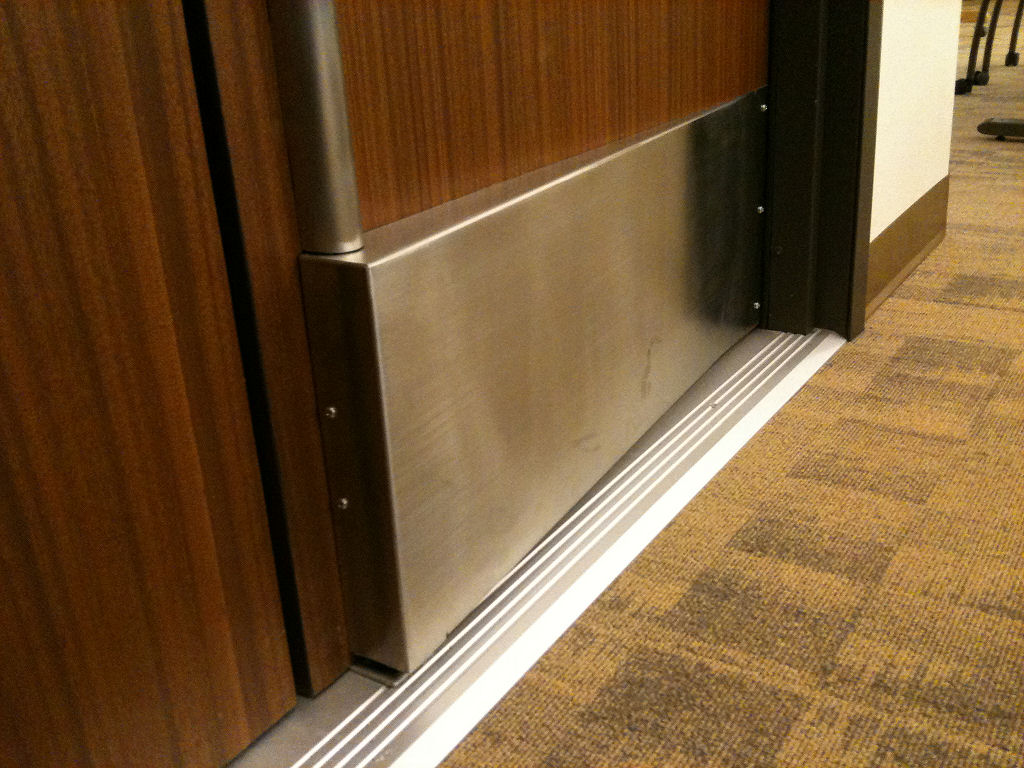

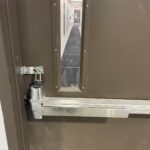
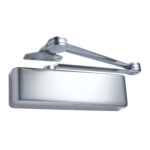

Ok, so here is my question/issue with this type of solution. Most people assume that the wheelchair/crutch/etc. will be traveling through the opening from the push side of the door which should be a correct assumption under emergency circumstances. But under everyday usage the wheelchair/crutch/etc. has the possibility to be moving through the opening from the pull side approximately half of the time. How would this type of solution resolve the issue of snagging something in that case or does the ADA standards not take that into consideration? I know they consider the pull side when it comes to pull and latch release pressures as well as no tight grasping or twisting motions. So why would they not consider this?
Hi Paul –
The reason this requirement applies only to the push side is that it is likely that a cane, crutch, or wheelchair footpad will be against the door – the person may use those devices to help them open the door and keep it open while they move through the opening. This would not be true on the pull side.
– Lori
Hi Lori, I may not have explained myself too well. I was referring to when the door has been opened from the pull side by the person who uses the cane, crutch or wheelchair and that person moving through is proceeding from said pull side. Now the door is needing to be held ajar while they move through, the edge created by this option may catch the wheelchair footpad or crutch much the same as if they were moving through the opening from the push side.
Paul – The same can be said for the very edge of the door.
T.J.,
Agreed, however the edge of the door has to been there because, well, it’s the edge of the door. The extended latch guard pictured above and every other one I have seen sits back off the edge of the door approximately 3-4 inches which now creates another edge that has to be maneuvered around. With the development of new products such as Fire Bolts (ideally for Fire Doors but not good for security, which usually isn’t an issue where these guards are needed the most ie. hospitals), I think that external bottom rod assemblies ought to be a thing of the past. I know that is not what a lot of manufacturers want to hear but there are manufacturers that have stepped up to the plate and developed new products that meet ADA and security needs, so if the other companies want to stay competitive maybe they need to step up as well. Just my $0.02 worth.
Paul
Oh – I see what you mean. Yes, it’s possible that the “high” edge of the wedge could catch something, but once the person maneuvers around the door edge and onto the wedge, there wouldn’t be a barrier from that point on.
– Lori
Lori,
Not meaning to sound condescending in any way (because I truly do value your insights) but, couldn’t the same be said for a non protected bottom rod? See my reply to T.J. above.
Paul
Nifty solution!
Given the example in the photo; this would also seem to be a possible snag issue with full opening of the door and someone catching their crutch, cane or chair between the edge of the guard and the plane of the door. Also this guard would have to be supported between the door and the face of the guard to prevent denting.
who is making these?
Oops – I probably should have included that. 🙂 It was in the original post. They are from Von Duprin (LGO-3 or LGO-4)…they are not a new product but the new information in the Commentary makes it more likely that an AHJ would accept them.
– Lori
these are heavy duty and are excellent for locations for loading materials. is ADA accessibility a concern in loading areas that are not normally used as a main entrance?
Hi Alex –
It depends…some employee work areas are exempt from the ADA requirements, but the access doors to the area are not. Rather than risk it, I usually assume everything has to meet the standards.
– Lori
I don’t see any issues with it. Seems identical to a few jobs Ive done in the past for clients who needed ADA compliance and had 3-3/8″ glass door rails. We simply turned them into 10-1/4″ tall rails by capping them then adding custom longer end caps. My only fear with that product shown would be it’s ability to take a good kick without denting and that’s not code related. We always used thick gauge cladding in conjunction with a solid backer like Lexan to fill up the void so when you kicked the door they felt solid and ding/dent free. I’ve done entire healthcare facilities with this method. Glass door manufacturers do the same things in their production facilities every day.
Lori,
Being an AHJ I would approve this as meeting the intent!! Lets be honest here though….Someone can get caught on ANY protrusion in a doorway. This device would greatly reduce that…but not totally eliminate it. I like to consider myself sort of a risk manager and if the intent is to reduce the chance of a hang-up while traveling through the door (from either side) all the better. Nice discussion!!!
Thanks Kevin!
– Lori